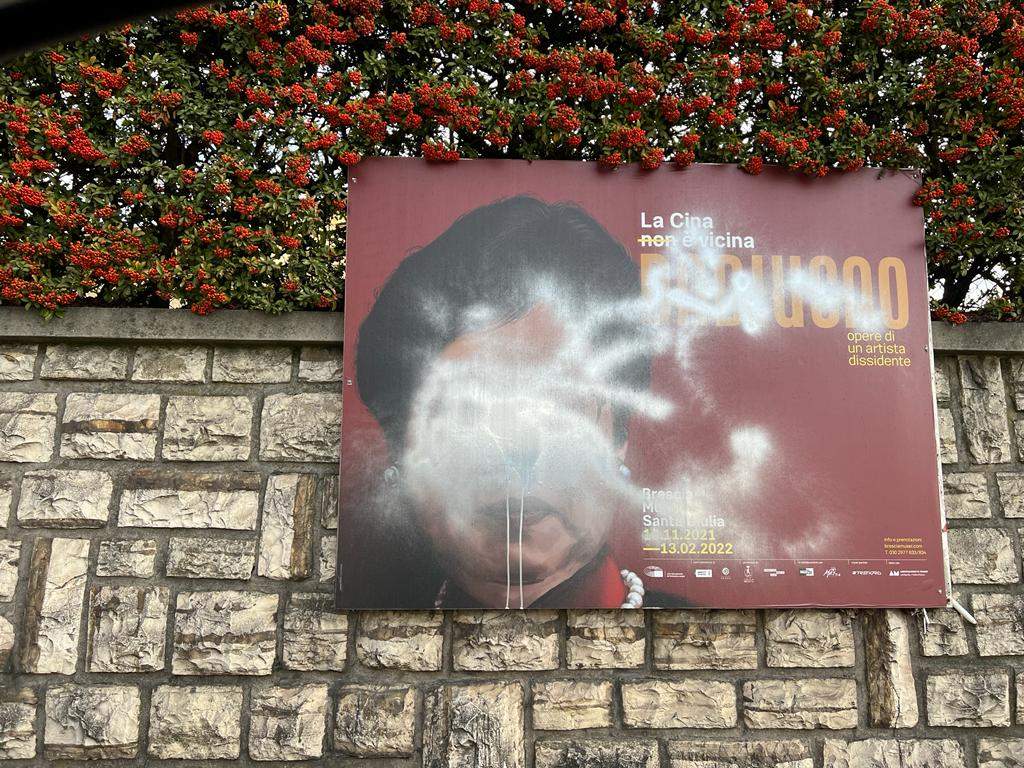Brescia, Badiucao exhibition posters vandalized throughout the city
Unfortunate fact in Brescia where the exhibition China (not) is Near, the first European solo show of Badiucao, a Chinese artist dissident with his country and exiled to Australia(read his story here), is underway at the Santa Giulia Museum. Over the past ten days, almost all of the fixed advertising installations (banners, totems, and banners), and a good part of the street billboards, posters, and posters placed in Brescia and dedicated to the exhibition, which will remain open until Feb. 13, 2022, have in fact been vandalized. According to Brescia Musei, a deliberate and consistent defacement matrix is clearly recognizable in the various vandalizations, as the vandals’ actions focused mainly on the technical and logistical information essential to the visit, such as the exhibition location and dates, title, and sometimes the guiding image chosen to promote the exhibition(Carrie Lam, 2018).
These are not, according to the organizers, simply the actions of ordinary defacements, as the exhibition is the first solo show in Europe dedicated to Badiucao, the pseudonym of the Chinese artist-activist known for his protest art. The exhibition traces Badiucao’s artistic activity, from his beginnings to his most recent works, which arose in response to the health crisis triggered by the Covid-19 pandemic. Through his blog, social media, and organized communication campaigns, Badiucao carries on his resistance work, one of the very few channels unfiltered by government control capable, for example, of broadcasting the stories of Wuhan citizens during the 2020 lockdown. Just in 2020 he was awarded the Václav Havel Prize for Creative Dissent by the Human Rights Foundation, intended for artists who creatively expose the deceptions of dictatorships.
Since, according to the organizers, it is clear that the actions carried out on the exhibition’s promotional materials in the city of Brescia are not an occasional vandalization, these actions denounce a clear intent of a censorious nature against the artist and the project’s promoters, the Municipality of Brescia and the Brescia Musei Foundation (even before the opening of the exhibition, pressure had already been brought to bear to hinder it). To counteract the violence inherent in these erasures, a symbolic gag on the project, the exhibition promoters, in agreement with the artist, decided not to remove or replace these promotional implants and to make known to the press and the public the violence inherent in these gestures, so that even such an action could consolidate the artist’s work of denunciation and the reasons for the artistic and cultural program staged in Brescia. In fact, the Brescia exhibition format dedicated to the narration, through contemporary art, of the violation of human rights and deprivation of freedoms proposes the interpretation of the most significant current historical phenomena through the revelations of dissident artists and activists, mostly unpublished in the West. Public safety authorities, including the Police Headquarters and the Local Police, have already been informally contacted and a complaint against unknown persons will soon be filed by Fondazione Brescia Musei, the owner of the advertising media.
“These acts of vandalism,” said deputy mayor Laura Castelletti, “show us once again how necessary an exhibition of such significance was in Brescia, deliberately included in the framework of the Festival of Peace, which, since its inception, has wanted to shine a spotlight on the violation of rights. There can be no peace without rights, not even in Brescia. Art in all its forms is increasingly an ambassador of the right to speech and free thought; the attempts at censorship at Badiucao’s exhibition are proof of how effective and necessary its messages are.”
“These kinds of violently censorious actions, ironically, reinforce the goals of the City of Brescia and Fondazione Brescia Musei,” comments Francesca Bazoli, President of Fondazione Brescia Musei, “and do not undermine the overall results of the project, providing, if anything, further visibility and impetus to support this program for democracy and freedom that is garnering enormous attention nationally and internationally, reverberating also in the high attendance of the exhibition spaces set up by Badicuao.” As of Nov. 12, in fact, there have been more than 13,000 visitors to the exhibition, including about 6,000 during the Brescia Peace Festival, of which the project was the flagship exhibition event; the remaining 7,000 in the month of December alone. Important numbers that stand out in the national scenario at a time like the present when exhibitions and museums are suffering heavily from the consequences of the fourth pandemic wave on people’s mobility and their propensity for cultural consumption. The media echo of the exhibition has not yet died down abroad either: the recent special of the American TV network CBS aired last Dec. 26 in the setting of the longest-running American TV show, “60 Minutes,” is plastic evidence of this.
Pictured is one of the vandalized posters.
 |
| Brescia, Badiucao exhibition posters vandalized throughout the city |
Warning: the translation into English of the original Italian article was created using automatic tools. We undertake to review all articles, but we do not guarantee the total absence of inaccuracies in the translation due to the program. You can find the original by clicking on the ITA button. If you find any mistake,please contact us.





























